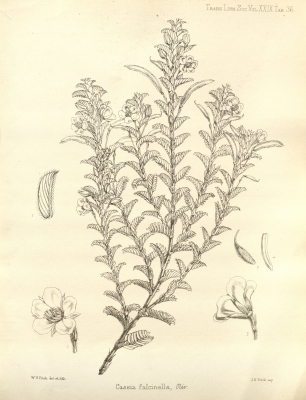Chamaecrista falcinella
(Oliv.) Lock
Fabaceae
This name is not universally accepted. The Flora of Tropical Africa treats this species as Cassia falcinella Oliv., and treats Chamaecrista falcinella as a synonym[
K- Title
- Plants for a Future
- Author
- Ken Fern
- Description
- Notes from observations, tasting etc at Plants For A Future and on field trips.
].
Common Name:
General Information
Chamaecrista falcinella is an upright or ascending, annual to perennial plant growing up to 60cm tall[
299- Title
- Protabase - Plant Resources of Tropical Africa.
- Publication
-
- Author
-
- Website
- http://www.prota.org
- Publisher
-
- Year
- 0
- ISBN
-
- Description
- An excellent on-line database with detailed information on over 3,200 species of useful plants of Africa.
].
The plant is harvested from the wild for local medicinal use.
Known Hazards
None known
Botanical References
308- Title
- Flora Zambesiaca
- Publication
-
- Author
-
- Website
- http://apps.kew.org/efloras/fz/intro.html
- Publisher
-
- Year
- 0
- ISBN
-
- Description
- An excellent online flora of plants from the Zambezi River basin. It lists a number of the plant uses as well as the habitats and botanical descriptions of the plants.
Range
Eastern and southern Africa - Uganda, Kenya, eastern DR Congo, Rwanda, Tanzania, Angola, Zambia, Zimbabwe, Mozambique, Namibia, Botswana.
Habitat
Mainly found in grassland at elevations from 1,000 - 1,800 metres[
299- Title
- Protabase - Plant Resources of Tropical Africa.
- Publication
-
- Author
-
- Website
- http://www.prota.org
- Publisher
-
- Year
- 0
- ISBN
-
- Description
- An excellent on-line database with detailed information on over 3,200 species of useful plants of Africa.
]. Miombo woodland and associated secondary bushland and grassland, often in sandy and sometimes damp places; at elevations from 1,500 - 1,750 metres[
308- Title
- Flora Zambesiaca
- Publication
-
- Author
-
- Website
- http://apps.kew.org/efloras/fz/intro.html
- Publisher
-
- Year
- 0
- ISBN
-
- Description
- An excellent online flora of plants from the Zambezi River basin. It lists a number of the plant uses as well as the habitats and botanical descriptions of the plants.
].
Properties
| Medicinal Rating |      |
| Habit | Annual/Perennial |
| Height | 0.50 m |
| Cultivation Status | Wild |
Cultivation Details
This species has a symbiotic relationship with certain soil bacteria; these bacteria form nodules on the roots and fix atmospheric nitrogen. Some of this nitrogen is utilized by the growing plant but some can also be used by other plants growing nearby[
755- Title
- Nodulation Plants in GRIN Taxonomy
- Publication
-
- Author
-
- Website
- http://www.ars-grin.gov/~sbmljw/cgi-bin/taxnodul.pl?language=en
- Publisher
- United States Department of Agriculture
- Year
- 0
- ISBN
-
- Description
- An online database listing plants that have either positive or negative reports on root and stem nodulation with nitrogen-fixing bacteria.
].
Edible Uses
None known
Medicinal
A decoction of the pounded leaves is drunk as a remedy for rheumatism[
299- Title
- Protabase - Plant Resources of Tropical Africa.
- Publication
-
- Author
-
- Website
- http://www.prota.org
- Publisher
-
- Year
- 0
- ISBN
-
- Description
- An excellent on-line database with detailed information on over 3,200 species of useful plants of Africa.
].
The pounded leaves, mixed with ghee, are rubbed on the skin to promote healing of broken bones[
299- Title
- Protabase - Plant Resources of Tropical Africa.
- Publication
-
- Author
-
- Website
- http://www.prota.org
- Publisher
-
- Year
- 0
- ISBN
-
- Description
- An excellent on-line database with detailed information on over 3,200 species of useful plants of Africa.
].
The pounded roots are mixed with water and drunk to treat diarrhoea[
299- Title
- Protabase - Plant Resources of Tropical Africa.
- Publication
-
- Author
-
- Website
- http://www.prota.org
- Publisher
-
- Year
- 0
- ISBN
-
- Description
- An excellent on-line database with detailed information on over 3,200 species of useful plants of Africa.
].
Other Uses
None known
Propagation
Seed - it has a hard seedcoat and may benefit from scarification before sowing in order to speed up and improve germination. This can usually be done by pouring a small amount of nearly boiling water on the seeds (being careful not to cook them!) and then soaking them for 12 - 24 hours in warm water. By this time they should have imbibed moisture and swollen - if they have not, then carefully make a nick in the seedcoat (being careful not to damage the embryo) and soak for a further 12 hours before sowing.
If you have any useful information about this plant, please leave a comment. Comments have to be approved before they are shown here.


 Useful Tropical Plants Database 2014 by
Ken Fern,
web interface by
Ajna Fern
with help from
Richard Morris.
Useful Tropical Plants Database 2014 by
Ken Fern,
web interface by
Ajna Fern
with help from
Richard Morris.